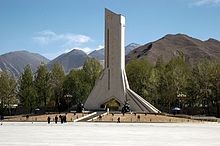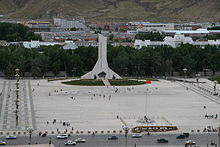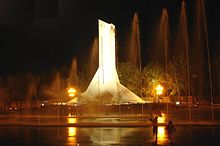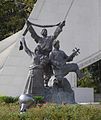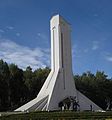- Monument to the Peaceful Liberation of Tibet
-
The monument to the Peaceful Liberation of Tibet stands in the southern part of the Potala square in Lhasa, just outside the protective zone and buffer zone of the world heritage site.[1] It celebrates what China calls the Peaceful Liberation of Tibet by the People's Liberation Army.[2]
The US$1.7 million, 37-meter-high spire-like concrete structure was designed by Professor Qikang of the South-East University of China.[3] It is shaped as an abstract Mount Quomolangma (aka Mount Everest).[4] The monument bears its own name engraved in the calligraphy of former general secretary and president Jiang Zemin, while an inscription refers to the expelling of "imperialist" forces from Tibet in 1951 and reports the socio-economic development achieved since then.[5][6]
The foundation stone was laid on July 18th, 2001 by Hu Jintao, the country's vice-president at the time[7] The monument was unveiled on May 22nd, 2002[8]
When apprized of the plans to build the memorial, the Tibetan government in exile claimed that "the monument would serve as a daily reminder of the humiliation of the Tibetan people." For Kate Saunders, spokeswoman for International Campaign for Tibet, the construction in this sensitive spot is a political message to Tibetans about Chinese rule over the region.[9]
Gallery
Notes and references
- ^ (French) Décision-25COM X.B-Ensemble historique du Palais du Potala, Lhasa (Extension pour inclure la zone de Norbulingka (Chine), 2001 :
- ^ To Zhu Weiqun, Executive Vice Minister of the United Front Work Department of the Central Committee of the Communist Party of China, "The peaceful liberation of Tibet completed the liberation and unification of China's mainland and was a victory over imperialist forces and a few upper-class Tibetans who wished to split Tibet from China" » (Peaceful Liberation Ushers in a New Era, BEIJING REVIEW.com.cn, July 25, 2011.)
- ^ Introduction to the Tibet's Peaceful Liberation Monument, Fifty Years in Tibet.
- ^ Monument to Tibet Peaceful Liberation Unveiled, China Tibet Tourism Bureau, 21-12-2007.
- ^ Monument to Tibet Peaceful Liberation Unveiled, op. cit.
- ^ Monument Erected to Commemorate Tibet Liberation, peopledaily.com.cn, Thursday, May 23, 2002: "The inscription on the monument says the People's Liberation Army expelled the imperialist forces from Tibet in 1951, which led Tibet to advancement, prosperity, democracy and opened a new era."
- ^ Photo: "Chinese Vice-President Hu Jintao and other leading members of the central delegation bury the foundation stone of the 'Monument to the Peaceful Liberation of Tibet' at the foundation laying ceremony held on the Potala Palace Square in Lhasa, capital of the Tibet Autonomous Region, Wednesday July 18, 2001."
- ^ Monument Erected to Commemorate Tibet Liberation, op. cit.: "A grand ceremony was held Wednesday in the Potala Palace in Lhasa to unveil the Tibet Peaceful Liberation Monument."
- ^ Anger over Tibet monument, BBC News, February 5th, 2002.
Categories:- Buildings and structures in Tibet
- Lhasa
Wikimedia Foundation. 2010.

